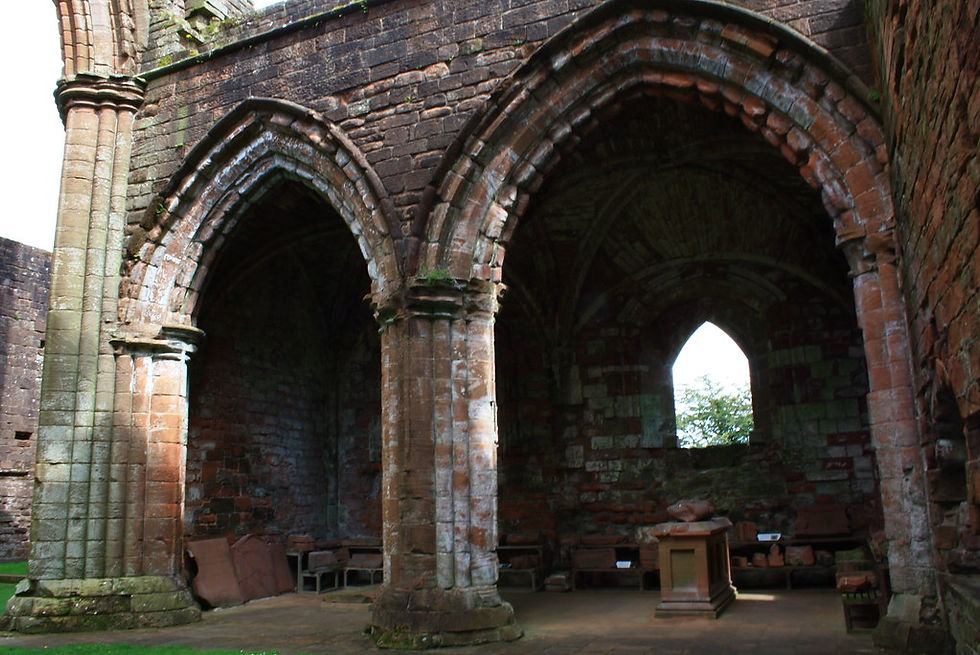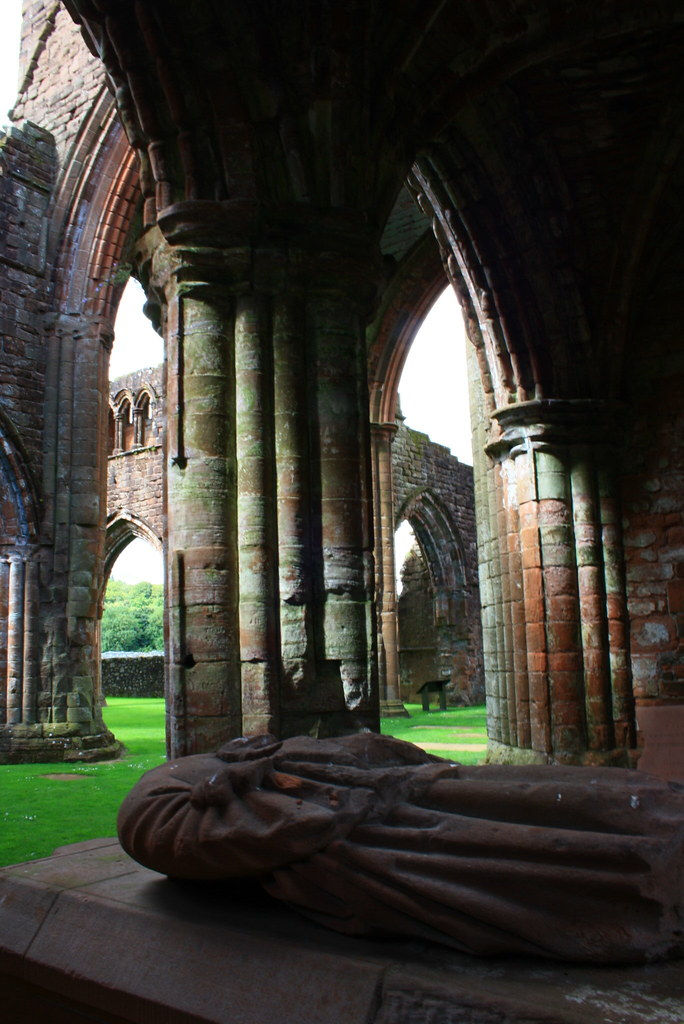Sweetheart Abbey: A Shrine to Love and Devotion
- Wee Walking Tours

- Mar 28, 2021
- 7 min read
Ruins of abbeys are found throughout Scotland and are a bittersweet reminder of the ravages of time as well as the Reformation. Yet, these once-glorious structures still retain glimmers of their former magnificence, and if one employs a wee bit of imagination, it isn’t too hard to envision them in their prime. There are stories that whisper to us from their stones- tales of devotion, love, and community. At least this is the case for out latest virtual adventure- join us as we head just outside Dumfries to the village of New Abbey to ‘explore and discover’ Sweetheart Abbey.

Before we make our entry through the West gate – lets briefly go over some monastic history. Sweetheart Abbey was an abbey in the Cistercian Order, and like all Cistercian monasteries, it was dedicated to the Saint of the Virgin Mary.

The monks were distinguished by their white robes, hence them being referred to as the White Monks. The Cistercian Order is known not only for their devout religious practice, but also for a rigorous work schedule. That is why most Cistercian abbeys and monasteries became prosperous, important centres of local communities. This was also true in the case of the Sweetheart Abbey, as it became quite wealthy from farming and sheep herding. The monks of the Sweetheart Abbey also operated an important Monksmill, on the location of the New Abbey Corn Mill. The Corn Mill is located at the other end of the town and it will definitely be a subject of one of our future posts.
The Cistercian Order was founded in France at the end of the 11th century. In 1136, the first Cistercian Abbey was founded in Scotland by King David I – Melrose Abbey. Shortly thereafter King David I co-founded the first Cistercian abbey in Galloway together with Fergus Lord of Galloway – Dundrennan Abbey (known as the last place on Scottish soil where Mary Queen of Scots spent time prior to her exile into England). Five decades later in 1192, Fergus’ grandson Roland Lord of Galloway founded the Cistercian Glenluce Abbey.
Now, Roland’s son Alan Lord of Galloway married Margaret of Huntingdon, a niece of the Scottish Kings- Malcolm IV and William the Lion- with a lineage to King David I. This is royal connection will become more relevant a bit later. Alan and Margaret’s daughter, Devorguilla (or Devorgilla) eventually became the Lady of Galloway and foundress of Sweetheart Abbey.
We will get back to Devorguilla shortly but let’s first enter the magnificent ruins of the Abbey. Before we make our way down the nave, let’s take a quick look at the cloisters. As we have discussed in some of our previous posts on abbeys, cloisters were the areas where the monks lived and worked, often just adjacent to the church itself. Unfortunately, here, the story repeats the similar line with most historic Catholic sites around Scotland – it was all destroyed in the aftermath of the Protestant Reformation. Therefore, only the foundations of Sweetheart Abbey’s cloister buildings remain. The granite stones were removed and taken one by one with most of the stones used in building other structures around the town. In any case, we can still make out the outlines for the gardens and interpret some of the other remaining stones to establish the historical use of some the rooms, such as the chapter house, the parlour, warming room, and the library.
Just beyond the cloister, would have stood all other supporting buildings that were used by the laymen. The laymen (often referred to as lay brothers) were local men who lived and worked by the abbey to help the monks with farming, herding, etc. It is believed that Sweetheart Abbey was home to about 15 monks, including the Abbot, who were assisted by about 40 laymen.
As we return to the nave and start to make our way towards the center, or the crossing, let your imagination run wild, because this abbey would have been absolutely incredible in its heyday- and it still is to this day. The red sandstone walls would have been painted white, with ornate stone-carved details glistening in the bright rays of the sun shining through a multitude of stained-glass windows. There would have also been a screen in the nave to divide and separate the monks from the laymen.
Once at the crossing, beneath the towering (28m) belltower, we’ll turn right to the south transept, because that is where we will find a fascinating tomb.
It is that of a woman, who seems to be clutching onto something and holding it against her chest. The tomb is severely damaged from the Reformation. Nonetheless, what remains is what was rediscovered and restored in the 20th. Meet Devorguilla, Lady of Galloway!
Devorguilla was known to be a lady of substance, and not just someone with the fortune of being born into a royal lineage. Then again, her father, Alan, was referred to in Norse Sagas as one of the greatest warriors of his time. Like her father, Devorguilla was just as comfortable around the Gaelic environment of Galloway, Royal Scottish courts, and with the English. In 1233, she married John de Balliol, an influential English nobleman, with connections to French nobility. John is perhaps best remembered for starting a college for the poor at the University of Oxford in 1263. Although, it’s important to note that most of the funding support for the college came from Devorguilla; she was also the one who made the endowment permanent in 1282, affirming the name Balliol College at Oxford (the name it still has to this day).
Together, Devorguilla and John had ten children, five sons and five daughters. Unfortunately for Devorguilla, she outlived most of her own children, and three of the oldest sons died prior to her without any heirs. That is why the fourth son, John, would become historically significant, but more on him in a minute.
By now, you might be wondering why this abbey is called Sweetheart Abbey, and it is time to share that touching story. The loving marriage between Devorguilla and John came to a devastating end when John died in 1268. This was heartbreaking for her, and she was not willing to let go. Instead, she had John’s heart embalmed and placed into a cask made from ivory. She wore the cask around her neck and carried it with her for the remainder of her life. In fact, for every meal she had afterwards, she also sat down to eat ‘with her husband’ by having his heart with her. A separate meal would be provided for the cask (his heart) as well, although those meals would be later given to the poor and needy.
Devorguilla wanted to honour her husband’s memory. Therefore, in 1273, drawing from her family’s legacy of building Cistercian abbeys– she decided to build one too. Initially the abbey was known as Novum Monasterium (new monastery) or simply as New Abbey. However, during the early stages of construction, the monks were so impressed with the love and devotion Devorguilla had for her deceased husband, they begin to refer to the abbey as ‘Dulce Cor’ which translates to Sweetheart – hence Sweetheart Abbey. And now you realise what Devorguilla’s sculpture in her tomb was holding onto – the heart of her sweetheart!
Wiping our eyes, we next move on to admire the precept, where the high altar would have stood. This would have been the main part of the church. A quick glimpse down reveals the original site of the Devorguilla tomb. She was originally buried there in 1289. And, yes, she was buried holding onto John’s heart against her own. The tradition of love and devotion at Sweetheart Abbey continues to this day as it is a popular location for wedding photos.
We continue to explore the North Transept, and admire the remaining details carved into the sandstone centuries ago. At this point, I would like to briefly cover some more history of the Abbey. After the passing of Devorguilla, Scotland entered a highly contentious period in her history.
Just about a year after Devorguilla’s death, Queen Margaret passes away without a clear heir to the Scottish thrown. Interestingly, had Devorguilla still been alive, she might have had a real strong claim to the crown. Nonetheless, the most direct heir ends up being a young child– Margaret, Maid of Norway, but she unfortunately dies at age seven. Without a clear line of succession, the crown is contested by the Balliol line and the Bruce line. Regrettably, Scotland turned to Edward I, King of England to arbitrate. This was most unfortunate because he had ambitions to rule Scotland himself.
Edward I chose Devorguilla’s oldest surviving son, John, and in 1292 crowned him – John King of Scots. John Balliol became a puppet of King Edward I. In fact, he would always kneel and bow before the English king – not exactly befitting for a Scottish king. This is why he became known as Toom Tabard, which translates to ‘empty coat’– essentially a ‘puppet king’. After four years, King Edward I, strips John of the crown anyway. This plunges Scotland into the Wars for Independence for the next 60 years.
As for the Sweetheart Abbey, it was severely damaged during those wars by the English (at one point it was used as a barracks by Edward I and his army). However, after the wars, it gained some wealthy patrons, especially the Douglas family. More specifically, it was Archibald Douglas, 3rd Earl of Douglas, who funded the restoration and rebuilding of the abbey in the second half of the 14th century. From there on the abbey existed in relative peace (not counting some small fires and lightning strikes) and it helped the surrounding region to develop and prosper.

I mentioned at the beginning this is also a story of community and this is due to a significant event that happened at the end of the 1700s. In 1779, a group of local community members bought Sweetheart Abbey as they wanted to preserve it. This was one of the first medieval buildings that was purposely preserved from further destruction. Sweetheart Abbey went under state care in 1927 and is now cared for by Historic Environment Scotland.

Before we leave this incredible site and its rich history, I recommend a leisurely walk around the grounds of the Abbey. Especially make sure to check out the precinct wall to the north of the Abbey. It is one of the best-preserved precinct walls in all of Scotland along with St Andrews Cathedral. This wall outlines the area of the Abbey. It would have been the first monks here, back in 1273, who would have cleared the field of all stones, so that the construction of the Abbey could commence. Those stones are still here today and are the ones that form the precinct wall.
Finally, we’ve included a video below of a brief virtual walk around the Abbey for you to enjoy (video credit to YouTube channel- chaldon2view):
Please note that Sweetheart Abbey has been closed for a while for repairs. Therefore, be sure to check out the Historic Environment Scotland website for updates on when you can plan a future visit.
Until next time – Explore & Discover!












